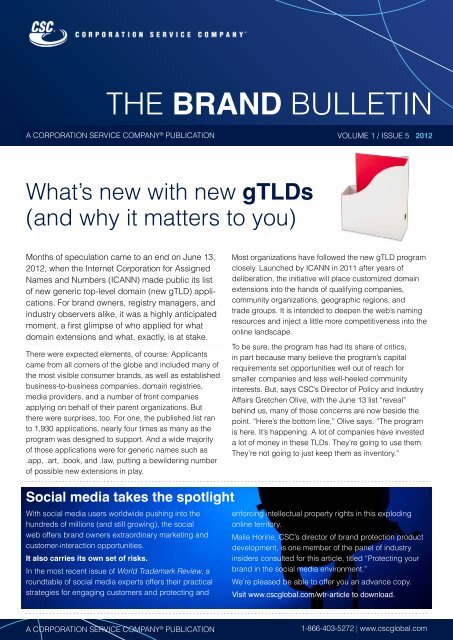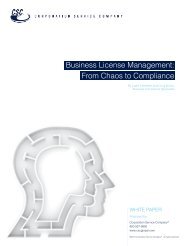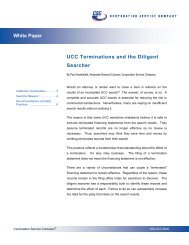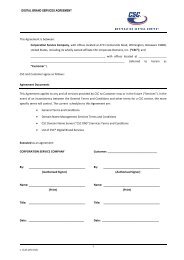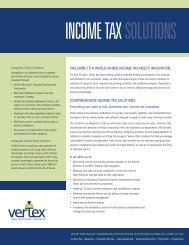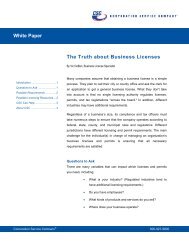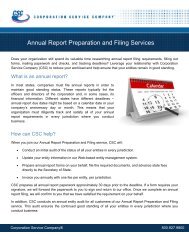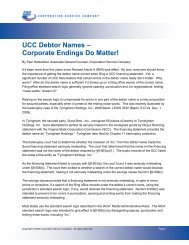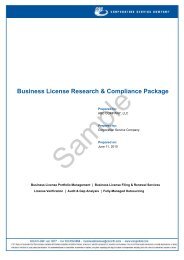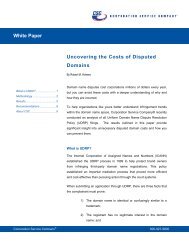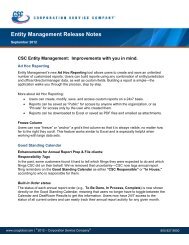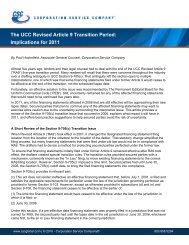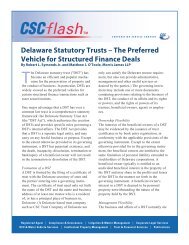THE BRAND BULLETIN - Corporation Service Company
THE BRAND BULLETIN - Corporation Service Company
THE BRAND BULLETIN - Corporation Service Company
Create successful ePaper yourself
Turn your PDF publications into a flip-book with our unique Google optimized e-Paper software.
<strong>THE</strong> <strong>BRAND</strong> <strong>BULLETIN</strong>A CORPORATION SERVICE COMPANY ® PUBLICATION VOLUME 1 / ISSUE 5 2012What’s new with new gTLDs(and why it matters to you)Months of speculation came to an end on June 13,2012, when the Internet <strong>Corporation</strong> for AssignedNames and Numbers (ICANN) made public its listof new generic top-level domain (new gTLD) applications.For brand owners, registry managers, andindustry observers alike, it was a highly anticipatedmoment, a first glimpse of who applied for whatdomain extensions and what, exactly, is at stake.There were expected elements, of course: Applicantscame from all corners of the globe and included many ofthe most visible consumer brands, as well as establishedbusiness-to-business companies, domain registries,media providers, and a number of front companiesapplying on behalf of their parent organizations. Butthere were surprises, too. For one, the published list ranto 1,930 applications, nearly four times as many as theprogram was designed to support. And a wide majorityof those applications were for generic names such as.app, .art, .book, and .law, putting a bewildering numberof possible new extensions in play.Most organizations have followed the new gTLD programclosely. Launched by ICANN in 2011 after years ofdeliberation, the initiative will place customized domainextensions into the hands of qualifying companies,community organizations, geographic regions, andtrade groups. It is intended to deepen the web’s namingresources and inject a little more competitiveness into theonline landscape.To be sure, the program has had its share of critics,in part because many believe the program’s capitalrequirements set opportunities well out of reach forsmaller companies and less well-heeled communityinterests. But, says CSC’s Director of Policy and IndustryAffairs Gretchen Olive, with the June 13 list “reveal”behind us, many of those concerns are now beside thepoint. “Here’s the bottom line,” Olive says. “The programis here. It’s happening. A lot of companies have investeda lot of money in these TLDs. They’re going to use them.They’re not going to just keep them as inventory.”Social media takes the spotlightWith social media users worldwide pushing into thehundreds of millions (and still growing), the socialweb offers brand owners extraordinary marketing andcustomer-interaction opportunities.It also carries its own set of risks.In the most recent issue of World Trademark Review, aroundtable of social media experts offers their practicalstrategies for engaging customers and protecting andenforcing intellectual property rights in this explodingonline territory.Malia Horine, CSC’s director of brand protection productdevelopment, is one member of the panel of industryinsiders consulted for this article, titled “Protecting yourbrand in the social media environment.”We’re pleased be able to offer you an advance copy.Visit www.cscglobal.com/wtr-article to download.A CORPORATION SERVICE COMPANY ® PUBLICATION1-866-403-5272 | www.cscglobal.com
If someone has applied for a TLD that matches or imitates one of yourtrademarks, or unfairly targets your community, you can declare youropposition to it.Naturally, many brand owners are wondering what’s next.If you’re one of them, read on.What’s your objection?Concurrent with ICANN’s June 13 publication of the newgTLD application list, the group opened an objectionfilingperiod. During this period, which ends on March13, 2013, brand holders seeking to protect their rightsand interests can file a formal objection to new gTLDapplications. If, for example, someone has applied fora TLD that matches or imitates one of your trademarks,or unfairly targets your community, you can declare youropposition to it.Applicants may file objections on four distinct grounds,as specified by ICANN:String Confusion: The applied-for gTLD string isconfusingly similar to an existing TLD or to anotherapplied-for gTLD string. Delegating two or more similarTLDs could cause user confusion.Legal Rights: The applied-for gTLD string violates thelegal rights of the objector.Limited Public Interest: The applied-for gTLD stringcontradicts generally accepted legal norms of moralityand public order recognized under principles ofinternational law.Community: There is substantial opposition to the gTLDapplication from a significant portion of the communitywhich the gTLD string is targeting.It’s important to note that ICANN has mandated thatobjections must be filed through a qualified disputeresolutionservice provider. The cost just to file can bequite expensive—running to more than $10,000 in somecases—so it calls for a judicious approach on the part ofbrand holders.Once the filing period has closed, objections will movethrough a dispute-resolution process. ICANN has saidthat objections “will be reviewed by a panel of qualifiedexperts in the relevant subject area.” ICANN-contracteddispute resolution providers are expected to beginhearing disputes in the April/May 2013 timeframe.Getting your house in orderWhen ICANN panel members start evaluating the nearly2,000 new gTLD applications, they will be lookingat applicants’ financial, operational, and technicalcapabilities only. They will not make value judgmentsabout whether the TLD is commercially viable or morallysound. Still, the potential addition of more than 1,000generic TLDs to the web space poses a worrisomequestion for any brand owner: How will they be used?“It’s important to get your house in order,” says Olive.“We now know what strings are possible. So now’s yourchance to start deciding what strings you might want toregister in and to watch the status of certain applicationsto see who winds up with them. You have to prepare withthose things in mind, making sure that whatever plan andenforcement strategy you come up with is scalable.”ICANN will release initial evaluation results in batchesof 100–125 per week from the end of March 2013through end of June 2013. It’s critical that brandowners register their trademarks with ICANN’s newlyestablished Trademark Clearinghouse to protect theirmarks in these emerging TLDs. As one of the rightsprotectionmechanisms built into the new gTLD program,the Trademark Clearinghouse will serve as a centraldatabase for authentication and validation of trademarkdata. (ICANN has chosen IBM to administer thedatabase and Deloitte to provide validation services.)ICANN expects that the Trademark Clearinghouse willbegin accepting trademarks by the end of Q1 of 2013.Regardless of when it happens, says Olive, “it’s importantthat brand owners allocate budget in 2013 in orderto be able to make those filings, so they’ll have theirtrademarks within the Trademark Clearinghouse prior tothe launch of these TLDs.”The start of a new beginningIn the past, launch and management of new top-leveldomains tended to be a patchwork affair, undertaken bystart-up ventures that were low on funds, experience, andorganization. That’s all changed. The pool of new gTLDapplicants includes more than 500 large, well-establishedbrands. “For the first time in the domain space, wehave capital, infrastructure, and people with strongbusiness acumen, all in one place,” says Olive. “Theseare companies that know how to drive ROI. They havesignificant resources, and they know how to market.”Companies will use their branded TLDs in some obviousways: as a means of simplifying their URL strings, toprovide a more personalized brand experience forcustomers, and to create an authenticated and secureMany experts are predicting a risein social engineering attacks oncethe new TLDs are rolled out, andif someone manages to registerdomains without your consent orcompromises your DNS in any way,your company’s reputation couldtake a significant hit.space in which to conduct business with partners,clients, and consumers. But the program will also unleasha cascade of other, less-understood effects, and smartorganizations—whether or not they’ve applied for aTLD of their own—will want to gird now for whateverdisruptions may lie in store.By the end of 2013 there may be 500 new TLDs “live” onthe Internet with an additional 500 coming online in thefirst two quarters of 2014, making the security of yourweb assets more important than ever. For those who haveapplied for a .brand, new gTLDs will place your brandfront and center. Many experts are predicting a rise insocial engineering attacks once the new TLDs are rolledGet yourhouse in orderout, and if someone manages to register domains withoutyour consent or compromises your DNS in any way, yourcompany’s reputation could take a significant hit. So it’scritical that you work with a registrar that offers stringentsecurity, enterprise-class data centers, and provenregistration policies and procedures.Ensuring that your new gTLD is profitable is equallyimportant. “If you’ve applied for a TLD, your companyis going to expect a return on investment. It’s time tofigure out the best use of this incredible new resource,”says Olive. “Mature companies typically do not turn on adime—it takes time to develop and get traction internallyon strategic changes. Waiting to start the dialogue onwhat your company could do until your application isapproved will put you at a competitive disadvantage withother applicants in your space.”The same goes for organizations that are looking toprotect their brand in the new Internet landscape buthave not applied for a new gTLD. According to Olive,“While the launch of most new gTLDs will occur overthe course of late 2013 through 2014, companies withlarge brand portfolios should not sit idle.” Now is the timeto prepare those Trademark Clearinghouse filings andidentify potential new gTLDs with strategic significance toyour business.“Competition will be fierce in many of the industryspecificTLDs, so taking the time now to understandthe Trademark Clearinghouse’s use requirements andexploring the utility of additional trademark filings couldput a company in a much better position when theseTLDs begin to launch,” says Olive. “Companies needto allocate budget for Trademark Clearinghouse filingsA CORPORATION SERVICE COMPANY ® PUBLICATION1-866-403-5272 | www.cscglobal.com
for 2013. For companies with significant trademarkportfolios, this could run as much as $20,000 to $100,000or more.”If this all sounds a little overwhelming, that’s because itis. And that’s exactly why it’s important to find a partnerthat can walk your organization’s stakeholders throughthe changes as they unfold, that has the industry insightto help you make the most of a changed Internet, andthat has the expertise you need to manage your newdomain extension(s) in the most secure and effective waypossible.It’s important to find a partnerwho can walk your organization’sstakeholders through the changesas they unfoldMeet the New gTLD ExpertsFor help finding your way in this rapidly evolving arena,turn to CSC for expert advice, cost-effective solutions,and forward-thinking strategies. We have services andsolutions available to help you:• Identify and file key trademarks with the TrademarkClearinghouse• Develop registration and brand protection strategiesthat maximize opportunities and reduce risk inupcoming new gTLD launches• Audit and analyze your current domain portfolio andpolicies to ensure they are scalable and providing amaximum return on your current domain investment,and• For new gTLD applicants, manage the setup,implementation, and ongoing operation of your .brand,as well provide industry-leading, enterprise-class newgTLD registrar services.Call 888-781-0596 or visit newgtlds@cscinfo.com todayfor more information and to arrange a free consultation.Make the most of anexpanding InternetFor much of its history, the Internet was a predominantlyEnglish-speaking medium. That is changing, however, withmore and more Internet users demanding, and receiving,content delivered in their first languages. A major factorenabling this change is the adoption of InternationalizedDomain Names (IDNs), domain names that allow for theinclusion of non-Latin characters, script languages andaccent marks.CSC’s latest brand protection white paper, “A World ofOpportunity: Making the Most of Internationalized DomainNames,” serves as a guide for brand owners to thisemerging space and offers several best practices they canemploy today to increase their brand security, internationalrecognition and customer engagement.Visit www.cscglobal.com/idn-whitepaper to download.About CSC:Founded in 1899, <strong>Corporation</strong> <strong>Service</strong> <strong>Company</strong> ®(CSC ® ) provides business, legal and financialservices to many of the world’s largest companies,law firms and financial institutions. An ICANNaccrediteddomain name registrar since 1999, CSCis the trusted partner of more than half the 100 BestGlobal Brands (Interbrand®) and the customerapproval leader for domain name services (WorldTrademark Review, 2010). CSC has an end-toendsolution for every brand protection need, fromstrategic domain registration and online monitoring todigital certificates and trademark screening.Visit www.cscglobal.com today to learn more.Missed an issue? Download yourcopy of The Brand Bulletin, issue 4 today byvisiting:www.cscglobal.com/brandbulletin4A CORPORATION SERVICE COMPANY ® PUBLICATION1-866-403-5272 | www.cscglobal.com


